Europe Flash Memory Market Size
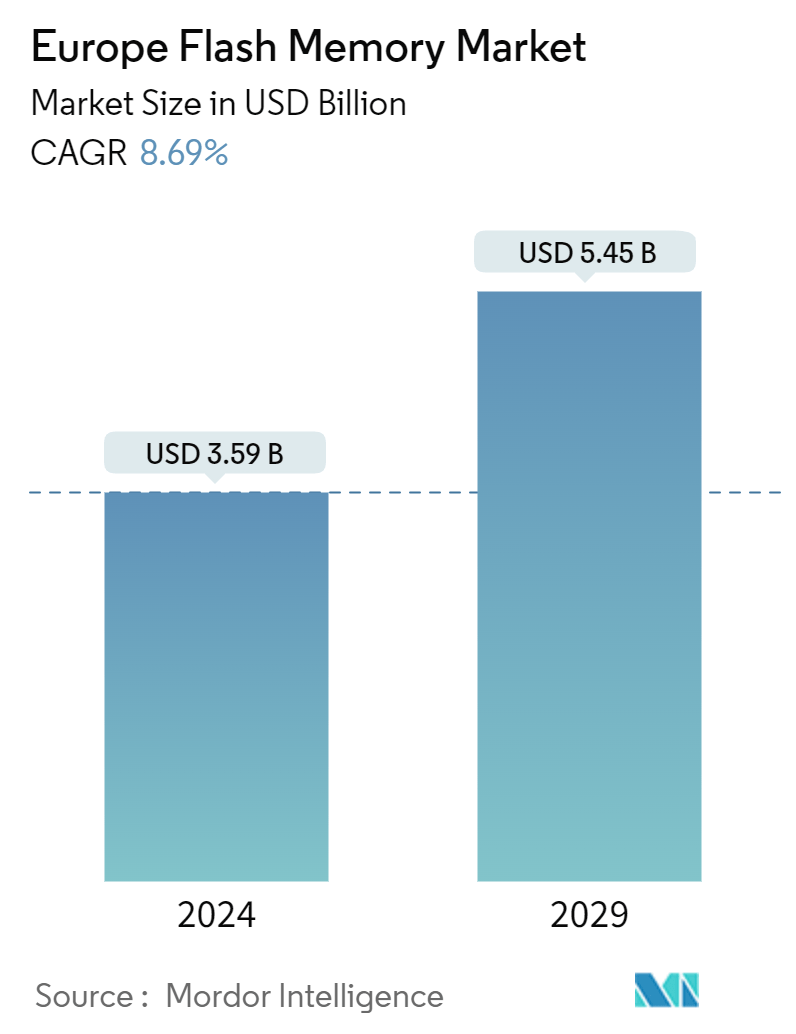
| Study Period | 2019 - 2029 |
| Base Year For Estimation | 2023 |
| Market Size (2024) | USD 3.59 Billion |
| Market Size (2029) | USD 5.45 Billion |
| CAGR (2024 - 2029) | 8.69 % |
| Market Concentration | High |
Major Players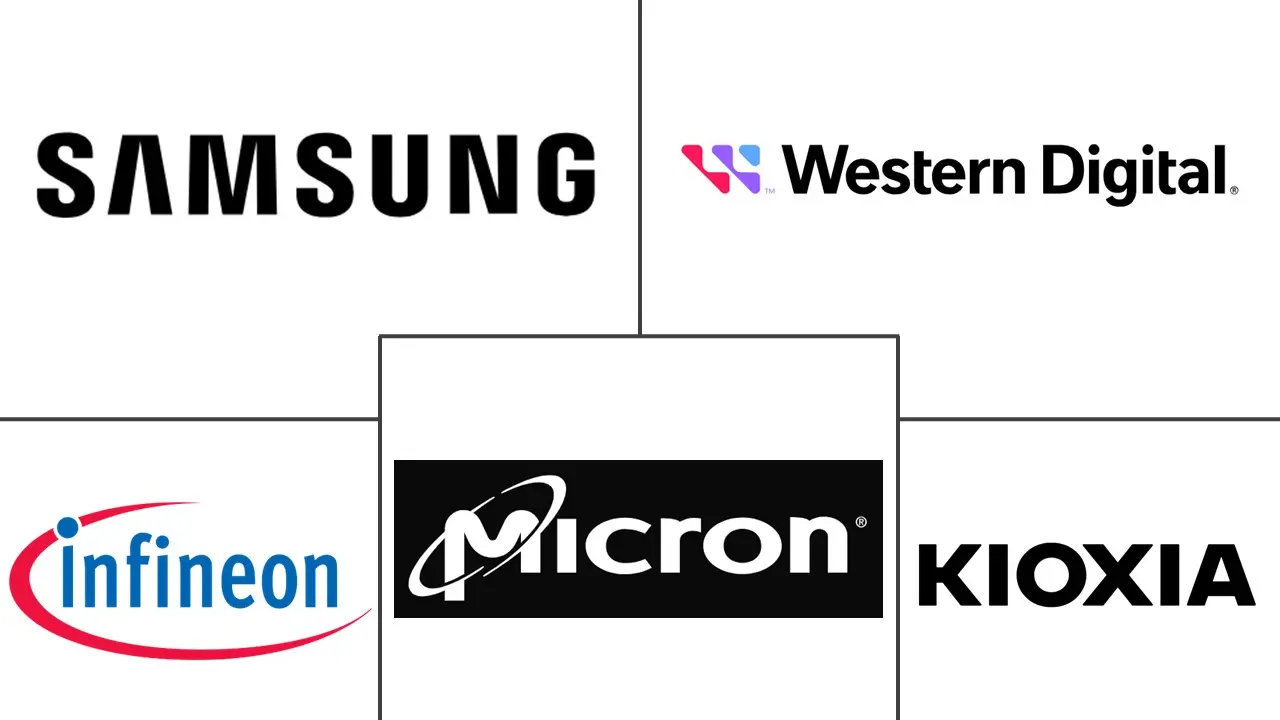
*Disclaimer: Major Players sorted in no particular order |
Europe Flash Memory Market Analysis
The Europe Flash Memory Market size is estimated at USD 3.59 billion in 2024, and is expected to reach USD 5.45 billion by 2029, growing at a CAGR of 8.69% during the forecast period (2024-2029).
The market growth is driven by the rapid adoption of NAND-based SSDs over traditional hard disk drives and rising demand for consumer electronics and automobiles.
- The 3D NAND flash memory is gaining momentum in the data center and Smartphone market. Thus, leading vendors in the market are focusing on building advanced flash memory. For instance, in March 2023, KIOXIA Europe GmbH announced a new 3D flash memory in cooperation with Western Digital Corp. The new flash memory offers exceptional performance, capacity, and reliability with advanced scaling and wafer bonding technologies, which makes it the best choice for a broad range of market segments to meet the demand of exponential data growth.
- The increasing investment to build data centers across European countries creates demand for flash memory as it is cost-effective, delivers high performance, is integrated with space and power savings, and provides better reliability than hard disks. For instance, according to Cloudsense, as of October 2022, Germany had the highest number of data centers in Europe, reaching 487. Following it, the United Kingdom and the Netherlands had 456 and 281 data centers, respectively.
- The rising demand for consumer electronics, partly driven by the increasing adoption of the Internet of Things (IoT), unlocks new growth opportunities for the flash memory market. Europe is a significant adopter of IoT. Though Germany, the United Kingdom, and the Netherlands are the leading countries in IoT adoption in the region, Eastern European countries and the Nordics are following closely.
- Also, according to CBI, the Centre for the Promotion of Imports from developing countries, European Internet of Things spending was estimated to reach EUR 184 billion USD 198.01 billion) in 2021 and is expected to experience double-digit growth through 2025. As per the organization, Europe is the third largest adopter of IoT after the Asia-Pacific region and North America.
Europe Flash Memory Market Trends
Automotive to grow with significant CAGR
- Automotive is expected to hold a significant share in Europe flash memory market during the forecast period. The European automotive sector has become one of the significant leaders in the global industry due to its numerous regional contributions, including those from Germany, the UK, and other nations. For example, according to the KBA motor transport authority, the total number of fully electric car sales in Germany increased by 44 percent to 57,980, representing a market share of 22.3% in 2022. Due to the high demand for electric vehicles, new-car registrations in Germany jumped 31% in November 2022.
- With the advancements in automotive computerization continuing to progress, flash memory is seeing use in a broader range of various automotive applications. The new high-performance automotive applications such as infotainment systems, advanced driver-assistance systems (ADAS), instrument clusters, and drive video/data recorders boost the demand for compute scalability resulting in increasing demand for low latency and high storage bandwidth.
- The next-generation self-driving cars or autonomous vehicles utilize various sensors and sensing cameras, which generate a huge amount of data every second and demand high-performance storage, such as flash memory, which is expected to push the market towards a growth trajectory. In line with recent trends, many players are expanding their product portfolio for automotive applications. For instance, LPDDR Flash memory was launched by Infineon Technologies AG in April 2023 to provide reliable, safe, and real-time code execution for automotive and zone controllers.
- Newer cars increasingly feature digital instrument clusters with an auxiliary display or an embedded dashboard that displays the meter indicator on-screen. The size of embedded displays has been expanding significantly as digital instrument clusters today often have 12-inch or larger full-HD displays. Accordingly, these larger displays are increasing the amount of content that needs processing, which, in turn, implies that the embedded flash memory on controlling MCUs alone cannot handle the load. External high-density flash memory is needed to support today's state-of-the-art digital instrument clusters, increasing the demand for the flash memory market.
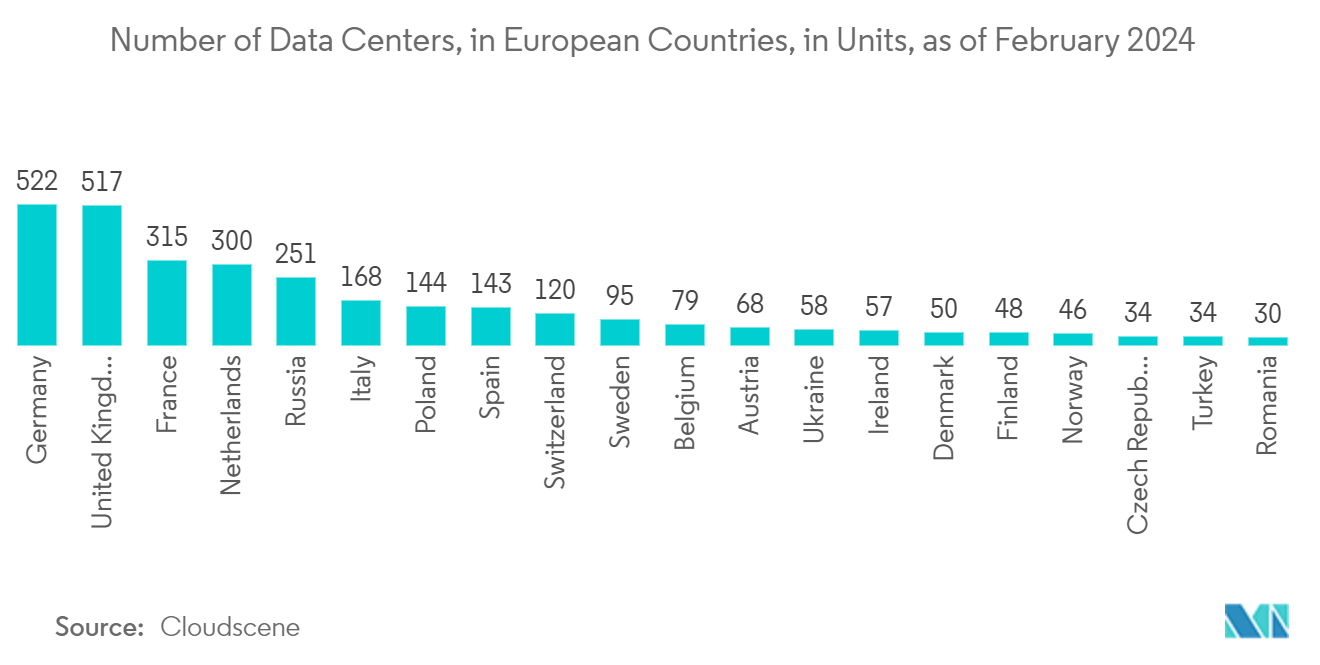
NAND Flash Memory to hold major market share
- NAND Flash Memory is projected to hold a significant share of the Europe flash memory market due to the growing adoption of smartphones and electric vehicles across the countries in the region. As per the European Automobile Manufacturers Association (ACEA), during the second quarter of 2022, the region's registrations of battery electric vehicles (BEV) grew by 11.1%, reaching 233,413 cars sold. With more electric vehicles introduced into the market, the demand for memory chips for such vehicles is anticipated to grow rapidly.
- Further, the majority of countries in Europe deployed commercial 5G services, and around two-thirds of telecom operators have introduced 5G networks in the region, according to GSM Association. In addition, the UK and Germany are expected to be the leading adopter of 5G in Europe at 61% and 59% adoption rates, respectively.
- According to the GSM Association, out of total connections, smartphones will account for 84% in Germany by 2025 from 80% in 2021. In March 2022, Vodafone Germany planned to achieve countrywide coverage of its 5G SA network that utilizes 700 MHz and 3.5 GHz spectrum by 2025. The '5G+' brand will be used by the company as the service rolls out across Germany. The 5G network penetration across the country drives smartphone market growth and is likely to create significant market opportunities for NAND Flash Memory.
- Moreover, the growing number of regional data centers will create new market opportunities for flash memory vendors. For instance, in December 2022, Data Castle started building its first data center in Germany. In addition, France-based data center organization Data4 planned to launch a new data center campus in Germany. Due to the reduced cost of the all-flash arrays over the last few years, flash memory gained more demand from data centers as SSDs lower energy consumption and reduce energy costs. These factors are expected to fuel the market for NAND flash memory.
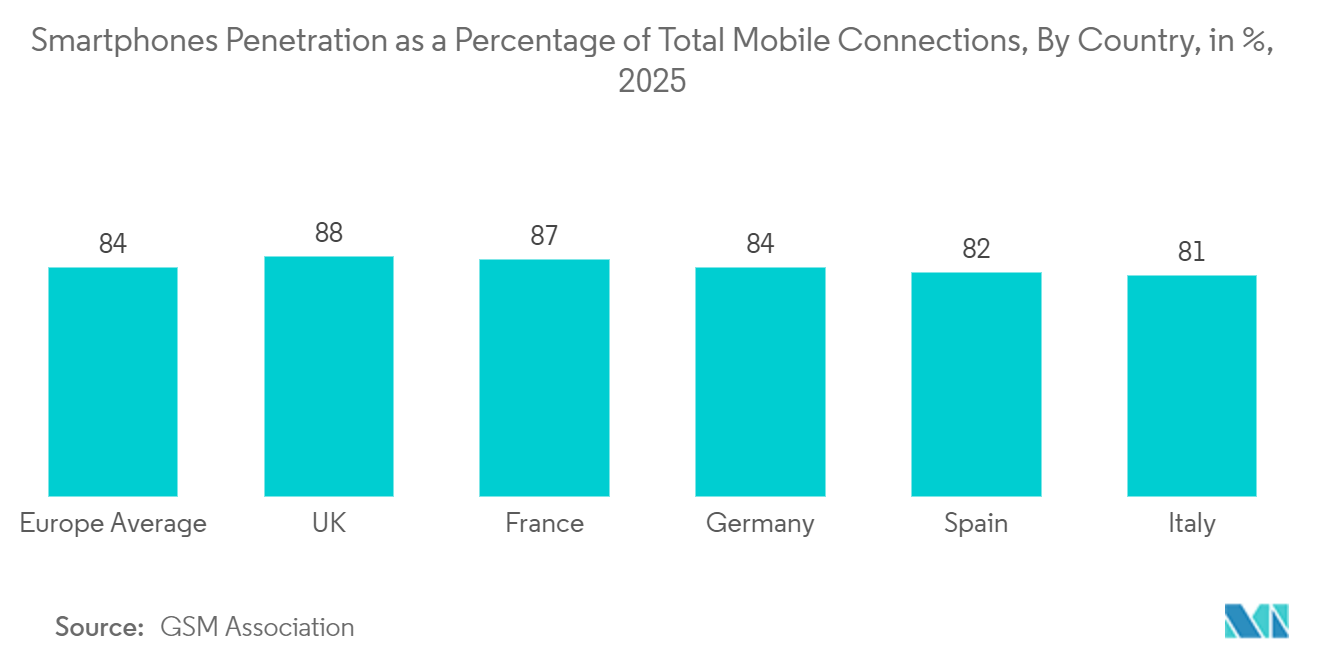
Europe Flash Memory Industry Overview
The Europe flash memory market is consolidated. The market is dominated by major vendors, such as Micron Technology, Samsung Electronics, Infineon AG, SK Hynix, and KIOXIA Europe GmbH. As the entry barriers in the market are high, the entry of new players is difficult. The existing vendors are investing heavily in the R&D of new and innovative products.
In February 2023, Infineon Technologies AG launched the SEMPER Nano NOR Flash memory for small-form-factor, battery-powered electronic devices. With the increasing demand for more memory, the company introduced new flash memory to deliver a solution comprising both high density and low power, design support, and robust engineering.
In July 2022, Micron Technology, Inc. announced that it had started mass production of the 232-layer NAND to increase the performance of storage solutions. In comparison to earlier generations of Micron NAND, the new NAND memory offers industry-leading areal density, more capacity, and enhanced energy efficiency, enabling best-in-class support for the most data-intensive use cases.
Europe Flash Memory Market Leaders
-
KIOXIA Europe GmbH
-
Samsung Electronics
-
Micron Technology
-
Infineon Technologies AG
-
Western Digital Corporation
*Disclaimer: Major Players sorted in no particular order
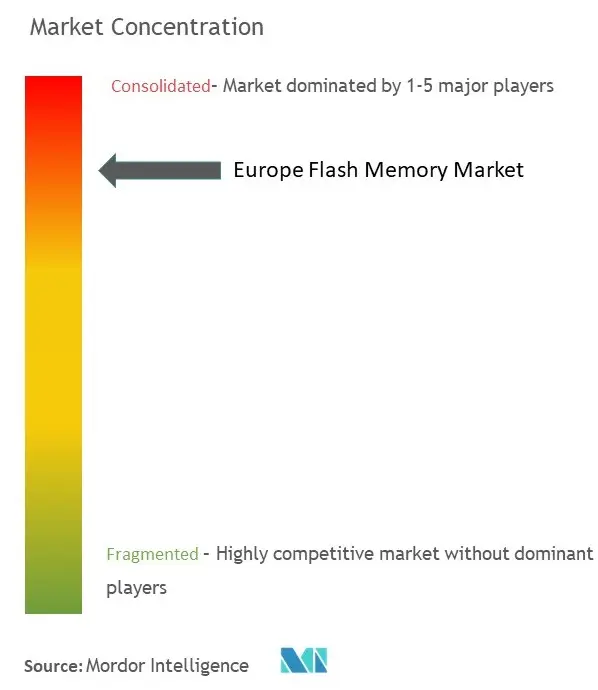
Europe Flash Memory Market News
- April 2024 - Infineon Technologies AG, one of the leaders in power systems and IoT is strengthening its outsourced backend manufacturing footprint in Europe and has announced a multi-year partnership with Amkor Technology, Inc., one of the leading semiconductor packaging and test services providers. With this long-term agreement, Infineon and Amkor further strengthen their partnership, extending the classical Outsourced Semiconductor Assembly and Test (OSAT) business model.
- April 2024 - KIOXIA Europe GmbH, one of the global frontrunner in memory solutions, has initiated the sampling phase for its newest iteration of Universal Flash Storage (UFS) Ver. 4.0 embedded flash memory devices. These cutting-edge products come in capacities of 256GB, 512GB, and 1TB, catering to a range of advanced mobile applications, particularly in flagship smartphones.
Europe Flash Memory Market Market Report - Table of Contents
1. INTRODUCTION
- 1.1 Study Assumptions and Market Definition
- 1.2 Scope of the Study
2. RESEARCH METHODOLOGY
3. EXECUTIVE SUMMARY
4. MARKET INSIGHTS
- 4.1 Market Overview
- 4.2 Supply Chain Analysis
- 4.3 Impact of macro trends (post-COVID-19 scenario, supply chain disruptions, and economic uncertainties among others) on the Market
-
4.4 Industry Attractiveness - Porter's Five Forces Analysis
- 4.4.1 Threat of New Entrants
- 4.4.2 Bargaining Power of Buyers/Consumers
- 4.4.3 Bargaining Power of Suppliers
- 4.4.4 Threat of Substitute Products
- 4.4.5 Intensity of Competitive Rivalry
5. MARKET DYNAMICS
-
5.1 Market Drivers
- 5.1.1 Growing Demand for Data Centers
- 5.1.2 Growing Applications of IoT
-
5.2 Market Restraints
- 5.2.1 Reliability Issues
6. MARKET SEGMENTATION
-
6.1 By Type
- 6.1.1 NAND Flash Memory
- 6.1.1.1 By Density
- 6.1.1.1.1 128 MB & LESS
- 6.1.1.1.2 512 MB & LESS
- 6.1.1.1.3 2 GIGABIT & LESS (greater than 1GB)
- 6.1.1.1.4 256 MB & LESS
- 6.1.1.1.5 1 GIGABIT & LESS
- 6.1.1.1.6 4 GIGABIT & LESS (greater than 2GB)
- 6.1.2 NOR Flash Memory
- 6.1.2.1 By Density
- 6.1.2.1.1 2 MEGABIT & LESS
- 6.1.2.1.2 4 MEGABIT & LESS (greater than 2MB)
- 6.1.2.1.3 8 MEGABIT & LESS (greater than 4MB)
- 6.1.2.1.4 16 MEGABIT & LESS (greater than 8MB)
- 6.1.2.1.5 32 MEGABIT & LESS (greater than 16MB)
- 6.1.2.1.6 64 MEGABIT & LESS (greater than 32MB)
-
6.2 By End User
- 6.2.1 Data Center (Enterprise and Servers)
- 6.2.2 Automotive
- 6.2.3 Mobile & Tablets
- 6.2.4 Client (PC, Client SSD)
- 6.2.5 Other End-user Applications
7. COMPETITIVE LANDSCAPE
-
7.1 Company Profiles*
- 7.1.1 Infineon Technologies AG
- 7.1.2 Micron Technology Inc.
- 7.1.3 Samsung Electronics
- 7.1.4 Kioxia Corporation
- 7.1.5 Western Digital Corporation
- 7.1.6 Intel Corporation
- 7.1.7 Microchip Technology Inc.
8. MARKET OPPORTUNITIES AND FUTURE TRENDS
9. INVESTMENT ANALYSIS
** Subject To AvailablityEurope Flash Memory Industry Segmentation
Flash memory is a non-volatile memory that electronically erases data in blocks and rewrites the data at the byte level. There are two types of flash memory - NOR flash and NAND flash. Flash memory is widely used for storage and data transfer in consumer devices, enterprise systems, and industrial applications. The scope of the study comprises the value and volume of flash memory.
Europe Flash Memory market is segmented by Type (NOR flash memory (by density (2 MEGABIT & LESS, 4 MEGABIT & LESS (greater than 2MB), 8 MEGABIT & LESS (greater than 4MB), 16 MEGABIT & LESS (greater than 8MB), 32 MEGABIT & LESS (greater than 16MB), 64 MEGABIT & LESS (greater than 32MB))), NAND flash memory (by density (128 MB & LESS, 512 MB & LESS, 2 GIGABIT & LESS (greater than 1GB), 256 MB & LESS, 1 GIGABIT & LESS, 4 GIGABIT & LESS (greater than 2GB))), by end user (data center (enterprise and servers), automotive, mobile and tablet, client (PC, client SSD)), other end-user applications). The report offers the market size in value terms in USD for all the abovementioned segments.
| By Type | NAND Flash Memory | By Density | 128 MB & LESS |
| 512 MB & LESS | |||
| 2 GIGABIT & LESS (greater than 1GB) | |||
| 256 MB & LESS | |||
| 1 GIGABIT & LESS | |||
| 4 GIGABIT & LESS (greater than 2GB) | |||
| By Type | NOR Flash Memory | By Density | 2 MEGABIT & LESS |
| 4 MEGABIT & LESS (greater than 2MB) | |||
| 8 MEGABIT & LESS (greater than 4MB) | |||
| 16 MEGABIT & LESS (greater than 8MB) | |||
| 32 MEGABIT & LESS (greater than 16MB) | |||
| 64 MEGABIT & LESS (greater than 32MB) | |||
| By End User | Data Center (Enterprise and Servers) | ||
| Automotive | |||
| Mobile & Tablets | |||
| Client (PC, Client SSD) | |||
| Other End-user Applications |
Europe Flash Memory Market Market Research Faqs
How big is the Europe Flash Memory Market ?
The Europe Flash Memory Market size is expected to reach USD 3.59 billion in 2024 and grow at a CAGR of 8.69% to reach USD 5.45 billion by 2029.
What is the current Europe Flash Memory Market size?
In 2024, the Europe Flash Memory Market size is expected to reach USD 3.59 billion.
Who are the key players in Europe Flash Memory Market ?
KIOXIA Europe GmbH, Samsung Electronics, Micron Technology, Infineon Technologies AG and Western Digital Corporation are the major companies operating in the Europe Flash Memory Market .
What years does this Europe Flash Memory Market cover, and what was the market size in 2023?
In 2023, the Europe Flash Memory Market size was estimated at USD 3.28 billion. The report covers the Europe Flash Memory Market historical market size for years: 2019, 2020, 2021, 2022 and 2023. The report also forecasts the Europe Flash Memory Market size for years: 2024, 2025, 2026, 2027, 2028 and 2029.
Europe Flash Memory Market Industry Report
Statistics for the 2024 Europe Flash Memory market share, size and revenue growth rate, created by Mordor Intelligence™ Industry Reports. Europe Flash Memory analysis includes a market forecast outlook to for 2024 to 2029 and historical overview. Get a sample of this industry analysis as a free report PDF download.



